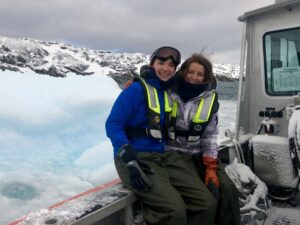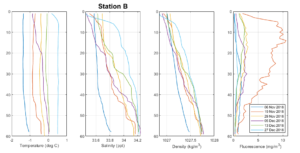-
Early Season at Palmer
Posted on January 7th, 2019 No comments2018 Spring Phytoplankton Bloom!
After 30 hours of travel from the US to Punta Arenas, Chile, and then a four-day transit on R/V Laurence M. Gould across the Drake Passage, Marie Zahn and Anna Bashkirova representing the Schofield team arrived on October 6th, 2018 to Palmer Station.
Typically foul weather conditions inhibit early season sampling, but this year’s open water and manageable winds allowed us to completely capture the first spring phytoplankton bloom, peaking around November 19th.
Wind speed decreased after the first week of November and sea ice retreated, allowing sufficient sunlight and water column stratification for a bloom. Stratification was especially pronounced November 15-19 and best observable in salinity and density values from CTD profiles collected at two locations: Stations B (nearshore) and E (offshore). This was accompanied by a steady rise in fluorescence, primary production, and chlorophyll concentrations, all three reaching a peak on November 19th. Strong winds beginning November 18th soon mixed the water column, quenching the bloom.
Our measurements of primary production (mg C/m2/day) and chlorophyll concentrations (mg/m2) dropped down after the spring bloom and have remained steady since. Fluorescence profiles also reflect the spring bloom (reaching nearly 10 mg/m3 at the chlorophyll maximum) and subsequent leveling-off to ~3 mg/m3 for both Stations B and E.
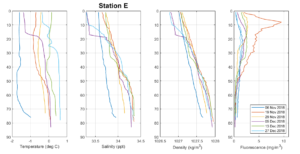
Temperature (˚C), salinity (ppt), density (kg m-3), and fluorescence (mg m-3) profiles against depth in meters (L-R) for six November and December 2018 sampling events at Station B (top row) and Station E (bottom row).
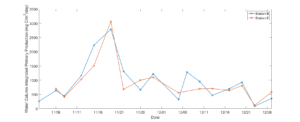
Depth-integrated primary production (mg C/m2/day) values from Station B (blue) and Station E (orange) for November and December 2018.
-
Introducing the Polar Oceans Blog
Posted on December 23rd, 2018 No comments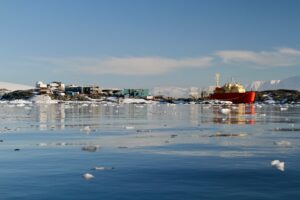
Palmer Station and ASRV Laurence M. Gould docked at the pier. Photo by Marie Zahn, summer 2018.Welcome to the RUCOOL Polar Oceans blog! Here we will share updates from our research conducted along the West Antarctic Peninsula (WAP) from Palmer Station and while aboard the R/V Laurence M. Gould. Our research contributes to the Palmer Long-Term Ecological Research (LTER) program (https://pal.lternet.edu) that monitors decadal ecological changes of the pelagic marine ecosystem along the WAP. The Palmer LTER program was established by the National Science Foundation in 1990 and combines efforts from several universities to examine the whole food web from bacteria to seabirds and cetaceans.
Our research objectives are to understand seasonal and interannual patterns and changes in the phytoplankton as well as the physical properties (temperature, salinity, and light) that affect them, especially as this region warms and shifts from a true Antarctic ecosystem to a more sub-Antarctic one. More specifically, we focus on how the physics and nutrient availability drive overall carbon fixation in the upper ocean and how that relates to higher trophic levels. Our routine analyses include discrete chlorophyll a measurements, 14C uptake to determine primary productivity, chemotaxonomic pigments via high performance liquid chromatography, fluorescence induction and relaxation kinetics, and whole water carbon fixation rates. We compliment these measurements with water column bio-optical profiles.
This austral summer marks our eleventh season at Palmer Station. Already it has been a productive one (pun-intended). Stay tuned for more updates and posts as we go deeper into some of our protocols and recent findings from our research here in Antarctica!



